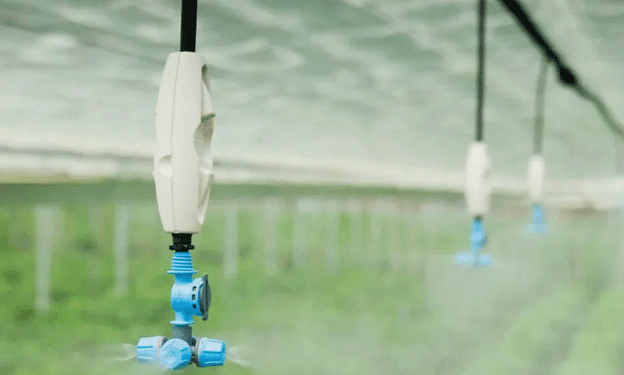Overhead Sprinklers: A Versatile Solution for Moisture-Tolerant Crops
While most crops require dry foliage to prevent diseases, certain plants thrive even with wet leaves, making overhead sprinkler irrigation a viable option. This system involves a network of main pipelines installed across the greenhouse. Risers and nozzles, positioned either on the ceiling or the floor, spray water uniformly over the plants from a height of approximately 60 cm for indoor flowers and 180 cm for other plants. The 360-degree rotating nozzles ensure even water distribution, and strategically placed trays between pots collect excess water, preventing waste and redirecting it back to the source.
Overhead sprinklers are particularly beneficial for ornamental flowers and some leafy greens that can tolerate and even benefit from wet foliage. This method can enhance the uniformity of water application, improve plant health, and optimize resource use in controlled environments.
Boom Watering: Precision for Greenhouse Propagation
Boom watering involves a longitudinal water pipe along the greenhouse ceiling, equipped with nozzles that dispense water or nutrient solutions over the crops. Advanced systems mount these nozzles on a motorized belt, adjusting the water output according to the speed of the nozzle’s movement over the plants.
This method is ideal for propagating cuttings and producing seedlings, as it disperses fine water droplets intermittently over the growing medium. This not only reduces ambient temperature but also maintains the necessary relative humidity for optimal seedling and cutting development. Boom watering systems, with their precise application and adaptability, can significantly enhance the efficiency and effectiveness of greenhouse operations.
Drip Irrigation: Maximizing Efficiency and Yield
Drip irrigation is an incredibly efficient system, delivering water at regular intervals directly to the plant roots through drippers and emitters along lateral lines. This method is a cornerstone of comprehensive irrigation strategies, known for its precise delivery of water, fertilizers, and nutrients. With an efficiency rate of 90-95%, compared to 60-70% in other methods, drip irrigation significantly reduces water, fertilizer, and nutrient wastage, leading to higher yields and better crop quality.
Though initially more expensive to install, drip irrigation proves economically advantageous over time. Its effectiveness in both greenhouse and open-field applications, particularly in arid and semi-arid regions, makes it a preferred choice among modern farmers seeking sustainable solutions.
Subsurface Porous Pipe Irrigation: Efficient Root-Level Hydration
The subsurface porous pipe irrigation system uses sponge-like porous pipes that deliver water, fertilizers, and pesticides directly to the root zone. Similar to drip irrigation but installed underground, these pipes, buried 20-25 cm below the surface, maintain a moisture-rich environment directly around the roots.
Advantages of this method include improved nutrient delivery, weed growth prevention, and the elimination of land leveling requirements. Subsurface irrigation enhances water use efficiency, promotes better root health, and reduces labor costs associated with surface irrigation systems.
Adopting advanced irrigation methods like overhead sprinklers, boom watering, drip irrigation, and subsurface porous pipe systems can greatly improve water use efficiency, crop yield, and overall sustainability in agriculture. While each method has unique benefits and specific applications, their strategic implementation can address various agricultural challenges, ensuring resource optimization and environmental conservation.










